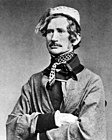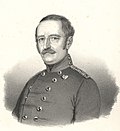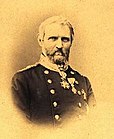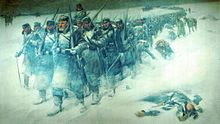Withdrawal from Danewerk

Schleswig in joy about the withdrawal of the Danish troops on Feb. 6, 1864, Austrian and Prussian officers in the streets, the Schleswig-Holstein flag on the buildings (color lithograph by Otto Bache )
| date | 5th-6th February 1864 |
|---|---|
| place | Danewerk |
| output | tactical success for Denmark, strategic success for the allies |
| Parties to the conflict | |
|---|---|
| Commander | |
|
Friedrich von Wrangel |
|
| Troop strength | |
| 61,000 158 cannons |
38,000 135 cannons |
Missunde - Königshügel - Danewerk - Schlei - Oeversee - Jutland - Vejle - Jasmund - Düppeler Schanzen - Fredericia - Helgoland - Alsen - Lundby - North Frisian Islands
The withdrawal from the Danewerk was a highly controversial decision in the German-Danish War , although most military historians today agree that it was inevitable. Today it is considered a military masterpiece, as the retreat was only cleared up by the enemy hours after it began.
procedure
De Meza's last council of war
On the afternoon of February 5, at 5 o'clock in the afternoon, Lieutenant General de Meza held his last council of war in the Prinzenpalais with all the generals and senior officers who were present. At that hour it was clear to the Danish officers that at least 23,000 Prussians would cross the Schlei at Arnis , 26,000 Prussians and Austrians would stand in front of the Danewerk and 11,000 Prussians at Missunde . These 10 officers were:
Also:
• Major Schröder
• Major Wegner
It was decided to move away from the Danewerk. The decision was taken almost unanimously at 6 p.m., only Lieutenant General Lüttichau raised objections. As an artillery officer, he did not want to give up the guns. The motivation for this decision was set out in seven points:
Considering,
1. That the durability of the Danewerkbildung is based on the obstacle afforded by the Eider, the Schlei and the floods. However, that the Schlei's obstacle is currently only a gully and that it is impossible to move in the immediate vicinity of the enemy.
2. That camping and bivouacking is impossible in the important sections of the year.
3. That an army strength of 40,000–50,000 men is necessary to defend the position, the current strength is 35,000 men.
4. That the composition and training of the army are inadequate.
5. That the enemy has gathered at least 50,000 men and has thus occupied the terrain which should be occupied by our outposts for security and which can hardly be regained. The enemy has also already established its artillery.
6. That an orderly retreat after the breakthrough is impossible.
7. That the instruction of the War Ministry of January 22, 1864 to the Chief General, as a condition for the resistance, demands not to continue the fight so far that the existence of the army as master is compromised.
From all of this, it was concluded that a voluntary withdrawal, leaving all the material in the positions behind, should take place in the early hours of February 6th. On February 6, 1864, the Danish army finally withdrew with its lieutenant general. He gives the order for evacuation without a fight.
retreat
Around noon a telegram was sent from the Bjelke Palace to the War Ministry and the King, informing them that the front was calm.
“There is some exchange of fire between enemy and trench artillery. There are no skirmishes, but the enemy is occupying the area more and more. The flanks are calm. The troops are suffering from the onset of frost. "
Preparation for withdrawal was not indicated. General De Meza left Schleswig for Flensburg. He left his chief of staff, Kauffmann, at headquarters. At 9:50 p.m., the latter sent the last telegram from Schleswig to the War Ministry in Copenhagen and to the King in Sonderburg:
“After a council of war was called yesterday, the high command decided to give up the Danewerk position. The army marches to Flensburg in the night. The material in the magazines is left behind. "
As a result, the telegraph connection was cut, so that neither the war minister nor the politicians in Copenhagen could issue an order to the contrary. The Allied enemies were also cleverly deceived by a request for a local armistice.
At 6 p.m. the retreat was initiated: the soldiers began to nail up the guns: a large nail was driven into the fuse tube, rendering the cannon unusable for the enemy. The marching orders were given to the individual units and the great Lindwurm set off in the direction of Flensburg, amazingly quietly . In the west, the 1st Division, whose main force lay north of the Schlei, began to march at around 8 p.m. The corresponding reserve - artillery left Schleswig even at 19 o'clock. The 2nd division was at Schuby and from 10 p.m. moved parallel to Flensburgstrasse near the Idstein forest. The 3rd Division to the east began its retreat at 10 p.m., as it was at risk from the crossing over the Schlei the next morning. This proceeded in two columns: First the 9th Brigade under Major General Steinmann with most of the artillery and cavalry . The second column followed about 1 ¼ mile behind and consisted of the 7th and 8th Brigades.
persecution
Though the last Danish troops Schleswig had left on February 6, 1864 at 1 am penetrated it only at 4 am the customer on the opposite side of the Danevirke the headquarters of Ludwig von Gablenz one. This immediately alerted the II Corps with which he set himself in motion as the avant-garde at 4:30 a.m. to pursue the enemy. It was Austrian troops who were the first to enter Schleswig. The general persecution was initiated by Alfred von Waldersee . He reported that the last Austrian battalion reached Gottorf Castle at 8:15 am. The Schleswig-Holstein flag was raised on all buildings . The cheering in the population was overwhelming. The Coronini regiment was determined to occupy the city. Prince Friedrich Karl was still standing with his troops on the eastern Schlei and still had to manage the crossing over the Schlei there. Nevertheless, the fleeing enemy was vigorously pursued over the next few days.
consequences
Not the withdrawal, but the occupation of the medieval Danewerk was probably the decisive mistake. The Danish army had to leave behind enormous values: 135 guns, 113 quintals of powder, 136,000 rounds of ammunition, loads of tools, blankets, straw, hay, wood and bacon.
Individual evidence
- ^ Michael Embree: Bismarck's First War: The Campaign of Schleswig and Jutland 1864, p. 82
- ↑ Tom Buk-Swienty : Schlachtbank Düppel: April 18, 1864. The story of a battle, Osburn Verlag 2011, p. 153
- ^ Michael Embree: Bismarck's First War: The Campaign of Schleswig and Jutland 1864, p. 87
- ↑ named after Johann von Prochaska-Coronini
Web links
literature
- Gerd Stolz: The German-Danish fateful year 1864. Husum, Husum 2010, ISBN 978-3-89876-499-5 .
- Winfried Vogel : Decision 1864. The battle near Düppel in the German-Danish War and its significance for the solution of the German question. Bernard & Graefe, Koblenz 1987, ISBN 3-7637-5840-2 .










